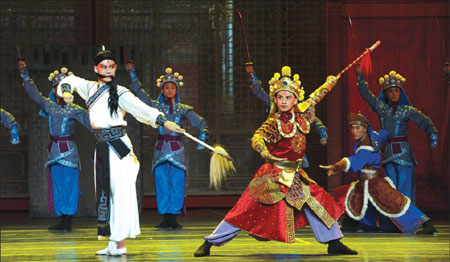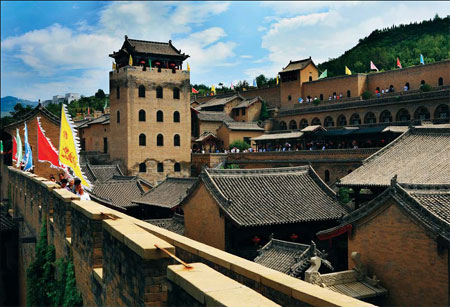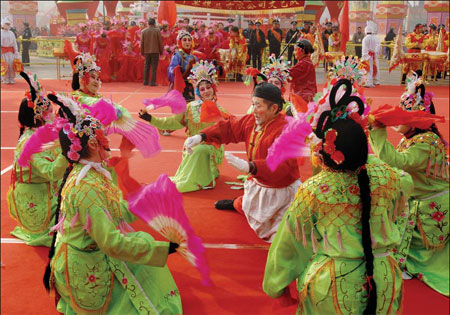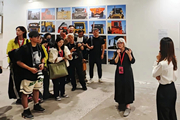News
Leaders: Famed coal region has more to offer
Updated:2012-10-31 07:50By Sun Ruisheng ( China Daily)
|
Based on stories of Chinese opera artists, Spring and Autumn on the Stage was presented at the Sydney Opera House with great success. |
|
The Imperial Prime Minister's Residence is now one of the top tourist landmarks in Shanxi. |
|
Enthusiasm for folk arts at grassroots level is one of the reasons behind Shanxi's cultural prosperity. Photos Provided to China Daily |
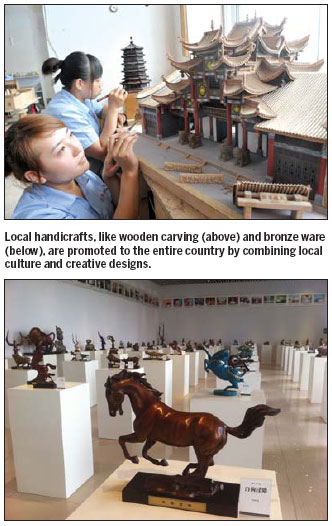
Shanxi shifting to a cleaner economy by developing tourism, cultural industries
Whenever Shanxi province is mentioned, the first thing that comes to the minds of many is its rich coal and other mineral resources.
However, local authorities want to present another picture by highlighting its long history, rich culture and the recent progress the province has made in arts, creativity and tourism based on such cultural legacies.
With a history of 5,000 years, the province is one of the places where Chinese civilization first took root, leaving rich cultural legacies that are embodied in the form of local operas, folk arts and ancient architecture.
Yuan Chunqing, Party chief of Shanxi, said cultural industries - including performance, handicrafts and art, creative enterprises, and cultural tourism - are expected to generate a total revenue of $16 billion yuan in 2015, accounting for 6 percent of its GDP.
He said one of the efforts of the local authorities to present Shanxi's culture is to stage various performances - operas, dramas, dances - at home and abroad.
A Handful of Sour Jujube, a grand modern dance drama by Shanxi Huajin Dance Troupe, was staged at John F. Kennedy Arts Center in New York on Dec 12, 2010.
A tragedy of two lovers in Shanxi, the drama was described by the Washington Post as "a Chinese edition of Romeo and Juliet".
The drama uses lighting effects and varied settings to remind audiences of the far-away homes of Shanxi merchants, the boundless desert and the dusty, wind-swept Great Wall of ancient China.
A Polish American named Rita said the beauty of the drama was well beyond her imagination and noted that "the plot reminded me of my far-away, ancestral home in Poland". She added that she believes the art has some sort of universal value with which people can identify regardless of his or her nationality.
In 2011, The Thousand-Hand Guanyin, a large-scale dance drama by Taiyuan Song and Dance Troupe, was presented in Singapore.
It depicts a legendary story of Guanyin, also known as Avalokitesvara. Guanyin is a Bodhisattva, an enlightened being sometimes worshipped as a deity, who helps to relieve the misery of all living creatures.
This year, another famed opera from Shanxi was performed overseas. Based on stories of Chinese opera artists in the early 20th century, Spring and Autumn on the Stage was staged at the Sydney Opera House on Jun 14.
"The dance is so fabulous, and I was truly enchanted by Chinese opera," said Bob Hawke, former prime minister of Australia.
As a finale of the China Culture Year in Australia, the show has played for four straight sections and achieved great success. Yet, it is not the first time an opera from Shanxi has won acclaim overseas.
As the first opera on the international stage, Fu Shan's trip to Beijing, an opera by Taiyuan Jin Opera Troupe, was entered as a contestant in the Chinese Opera Festival in Paris in 2007, where it was awarded the prize for Best Traditional Show.
Meanwhile, Shanxi is also showing its literature and art to the rest of the country through TV programs, movies, books, dramas and exhibitions.
Yang Yuan, head of the provincial information department, said that during the 11th Five Year Plan (2006-10) period, there were altogether five dance dramas selected to be a part of the National Stage Arts Project.
"During the Shanxi Culture and Art Exhibition Month in Shanghai last year, we achieved great success with 40 performing tours around the Yangtze River Delta Area," said Yang.
The number of audience members during these tours was about 100,000, with revenues reaching $616,207, he added.
Creativity industry
While authorities are considering ways to promote and protect local culture, entrepreneurs are seeing an opportunity to cash in on these legacies through "innovative development" and "rational utilization", local officials said.
This has led to a boom of creative enterprises and cultural tourism.
As a result, all 11 prefectures and prefecture-level cities in Shanxi have seen rapid growth in these industries.
In 2011, the value produced by creative industries in the provincial capital of Taiyuan reached a total of 920 million yuan ($147 million), with net profit amounting to $24 million.
Related enterprises in Taiyuan's high-tech industrial zone have produced more than 800 innovative cartoons, many of which have aired on CCTV and provincial TV channels.
Furthermore, 32 of its original cartoons were given Best Animation awards, and one entered the overseas market. Local companies have produced a large number of online games as well.
Shanxi is also home to cities with a strong reputation for traditional artistic industries, such as the southeastern city of Jincheng, which has long been renowned for local handicraft in porcelain and glassware.
Today, companies in the city are promoting those products to the entire country by combining local culture and creative designs.
For instance, Qiaofeng Ceramics Co has created porcelain inspired by local scenic spots, such as the Royal Prime Minister's Residence and other ancient residential buildings.
In the central city of Jinzhong, efforts have been made to integrate culture with tourism.
The local government has invested $75.22 million to construct the Impression Pingyao, a large-scale cultural tourism project combining sightseeing facilities and performance. It is expected to be complete in 2013 and will cover an area of 233,100 square meters.
Pingyao is an ancient city in Jinzhong with intact city walls as well as streets and residences that date back to the 18th and 19th centuries.
Luliang, another city in the western part of the provinces, is highlighting its Xiaoyi shadow plays and puppets and its ancient liquor-making techniques as tourism attractions.
The city's Xinghuacun Fenjiu Cultural Tourism Park - a liquor-themed park - received more than 70,000 visitors in 2011 and its annual revenue reached $640,215.
Meanwhile, some major events are being held to help Shanxi promote local culture and attract tourists, such as the Wutai Mountains Buddhist Culture Festival and the Yungang Grottoes Cultural Tourism Festival in Datong.
Grassroots initiatives
Provincial and city-level authorities are trying to use cultural resources to facilitate a new pattern of growth that relies less on natural resources, and various initiatives at the grassroots level have played an important role in this transformation.
One example is the 1.7 sq km Huangcheng - or Imperial City - village in the city of Jincheng.
Over the past 30 years, the village's 200-odd households have already made a fortune through coal mining.
"Coal mining is not a long-term strategy for sustainable development," said Zhang Jiasheng, head of the village.
A new highlight of Huangcheng's development is tourism, which is based on a huge ancient residential complex, the Royal Prime Minister's Residence.
It is the former home of Chen Yanjing, the teacher of Emperor Kangxi in the Qing Dynasty (1644-1911). Chen was also in charge of the compilation of the Kangxi Dictionary, the most authoritative dictionary in ancient China.
The 36,000 sq m complex is a group of castle-style official residences that climb all the way up a mountain slope.
Today, this renovated resort has become one of the top tourist landmarks in Shanxi, and the National Tourism Administration named it a 5A scenic spot, the highest class granted by the central government.
Ancient legacies
The Huangcheng village is only one of the places scattered through Shanxi with a wealth of ancient architecture.
Chang's Residence in Jinzhong, Qiao's Residence in Qixian and Cao's Residence in Taigu - to just name a few - all represent a high level of ancient residential architecture in China.
Shanxi possesses the largest number of State-protected historical sites and 70 percent of China's preserved wooden structures dating back to before the Song (960-1279) and Jin (1115-1234) dynasties. It also ranks third in terms of the quantity of world heritage sites.
Based on these historical sites, five to 10 big cultural tourism resorts will be built, each with an investment of more than 100 million yuan, according to Zhang Mingliang, head of the culture department of the provincial government.
These efforts will include building the Wutai Mountains into the largest Buddhist center in North China and a popular destination for tourists.
"Only when culture is fully integrated into tourism can we achieve positive growth," said Zhang, adding that culture is the soul of Shanxi's tourism, and tourism in turn plays a key role in promoting local culture.
"Our goal is to take the lead in China's tourism market by improving cultural influence," Zhang said.
sunruisheng@chinadaily.com.cn

Pingyao smoked meat
Pingyao smoked meat is an indispensable dish for locals at banquets and it is also hugely popular with tourists.

